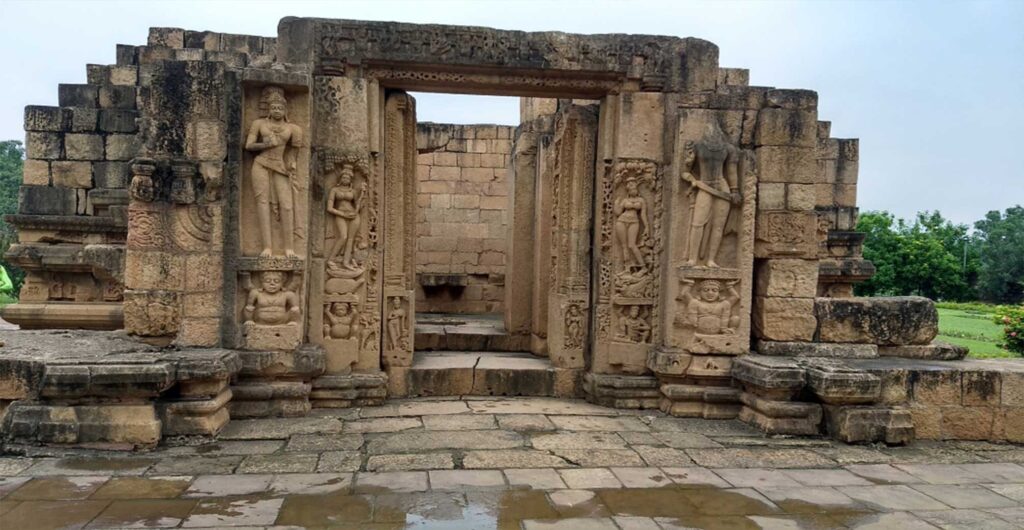
Malhar is located at a distance of 13kms from Masturi and 30kms from Bilaspur in the rural terrains towards the south-east direction. The Malhar region has ancient, historical, religious, natural, cultural and archaeological significance. In Indian scriptures the area is referred as South Kosala. Legendary king Lord Sri Rama of suryavansi clan is said to have coronated his son ‘Kusha’ as the king of this region with its capital in ‘kushasthalipura’ or ‘Kushavati’. The archaeological excavation evidences indicates the chronological sequence of urban development which took place during Maurya, Shunga and Satvahanas (350BCE -300CE); Sharabhpurias and Somvanshies (300-900CE); and finally Kalachuris Dynasties (900-1300CE). The glory of Malhar spread as Hindu cultural stock in ancient times and as trade route centre because it provided a passage through Kaushambi to Puri and towards the ports of eastern coast. This pious place surrounded by three rivers (arpa, leelagar & shivnath) is famous for its exquisite temples. The architectural heritage of Malhar is dominated by circular precincts of mud rampart fort circumambient by moats, two Rajmahal palace buildings towards the south of the fort and an open ground with a canopy of deciduous forest and shrub. Conspicuous fort remains are now lost grandeur in the sands of time scattered throughout the area in the form of mounds and ruins. Pandav-Bheem-Kichak temple, Deur or Devri temple, Pataleshwar temple, Dindeshwari temples are located near the palace outside the fort peripheries in southern and eastern part of Malhar city. The Chaturbhuja-Vishnu image (discovered in 1960 dated back to 200 BCE) is significantly an oldest known sculpture as it bears a Prakrit inscription in Brahmi script. Besides this many coins and sealings of Kanishka dynasty has been found.
Pataleshwar Temple is in the list of ‘Ancient monuments and Archaeological Sites and Remains of National Importance’; maintained by ASI, the Govt. of India. Pataleshwar Temple originally called as Kedareshwar temple dedicated to lord Shiva is situated towards north-east of Deur Temple and west of Dindeshwari Temple. The Temple was built by Somraja, a provincial governor in the reign of Kalchuri King Jajalladeva II (Ratanpur Kalchuri Regime) during 12th century (1167CE). This Bhumija style (rotating square circle principle applied to construct spire) Hindu temple has a speciality of 108 angles ground base foundation with six feet high platform having three side entrance and a square sanctum exhibiting exquisite architectural beauty. The sanctum is located below the ground floor deriving its name as Pataleshwar (the lord of netherworld). The temple is west facing housing black gleaming stone Gomukhi Shivalinga in the garbhgriha (womb chamber or sanctum) accessible through downward steps. In front of the temple is open Nandi mandapa. The remains of various pillars give assumption of pillared mandapa in front of sanctum. The sanctum doorway has life size statues of river goddess Ganga, Yamuna and Narmada with their vahanas and other dvarpalas. Lateral faces of the door-jambs are carved with five panels each depicting Ganesha with his consort, Uma-Maheshwara, Tripurantaka etc. The foundation stone platform depicts figures, like rows of elephant, flower patterns and mythological scenes. It is a general assumption that Water Consecration on this Shivalinga reaches the abyss. Only the lower part of the temple is surviving today and the dilapidated sculptures are scattered around the site. ASI has established a museum nearby the temple to house and treasure these invaluable sculptures, statues of Hindu deities Jain Tirthankaras and Boddha Monks. Every year during Mahashivtari fifteen days fair is observed in Malhar City Council.
